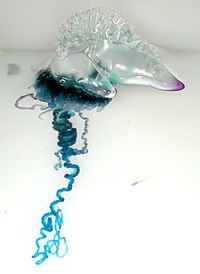
Photo from wikipedia
A dysfunctional epidermal barrier, which may be associated with mutations in the filaggrin gene in genetically predisposed individuals or harmful effects of environmental agents and allergens, contributes to the development… Click to show full abstract
A dysfunctional epidermal barrier, which may be associated with mutations in the filaggrin gene in genetically predisposed individuals or harmful effects of environmental agents and allergens, contributes to the development of atopic dermatitis (AD) due to an interplay between the epithelial barrier, immune defence and the cutaneous microbiome. The skin of patients with AD is frequently over‐colonized by biofilm‐growing Staphylococcus aureus, especially during flares, causing dysbiosis of the cutaneous microbiota and a decrease in bacterial diversity that inversely correlates with AD severity. Specific changes in the skin microbiome can be present before clinical AD onset in infancy. Additionally, local skin anatomy, lipid content, pH, water activity and sebum secretion differ between children and adults and generally correlate with the predominant microbiota. Considering the importance of S. aureus in AD, treatments aimed at reducing over‐colonization to rebalance microbial diversity may help manage AD and reduce flares. Anti‐staphylococcal interventions in AD will contribute to a decrease in S. aureus superantigens and proteases that cause damage and inflammation of the skin barrier while concomitantly increasing the proportion of commensal bacteria that secrete antimicrobial molecules that protect healthy skin from invading pathogens. This review summarizes the latest data on targeting skin microbiome dysbiosis and S. aureus over‐colonization to treat AD in adults and children. Indirect AD therapies, including emollients ‘plus’, anti‐inflammatory topicals and monoclonal antibodies, may have an impact on S. aureus and help control bacterial diversity. Direct therapies, including antibacterial treatments (antiseptics/topical or systemic antibiotics), and innovative treatments specifically targeting S. aureus (e.g. anti‐S. aureus endolysin, and autologous bacteriotherapy), may be effective alternatives to mitigate against an increase in microbial resistance and allow a proportionate increase in the commensal microbiota.
Journal Title: Journal of the European Academy of Dermatology and Venereology
Year Published: 2023
Link to full text (if available)
Share on Social Media: Sign Up to like & get
recommendations!